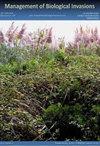Epiblema minutana (Lepidoptera, Tortricidae) in Israel: Promise or Peril?
IF 1.2
4区 环境科学与生态学
Q3 BIODIVERSITY CONSERVATION
引用次数: 0
Abstract
Parthenium weed ( Parthenium hysterophorus L.) is a noxious weed and a flagship invasive that has been spreading throughout Israel and the Palestinian Authority since 1980. In other regions affected by this invader, parthenium weed has been managed through classical biological control releases of Epiblema strenuana , a stem-galling tortricid moth native to North America. More recently, a congeneric moth, Epiblema minutana has been identified from Israel. To better understand the implications of E. minutana for controlling parthenium weed, we investigated the spread of E. minutana within Israel and the Palestinian Authority from 2012 to 2019 and explored its host range. We used a series of no-choice experiments in field cages to evaluate damage on naturalized Ambrosia spp., Xanthium italicum and parthenium weed as well as potential non-target, commercial cultivars of sunflower ( Helianthus annuus L.) and niger ( Guizotia abysinnica (L. f.) Cassini). We also evaluated damage in the field, where we found substantial gall formation on Ambrosia spp. , but none on P. hysterophorus or other genera. The geographical distribution increased from an estimated 424 km 2 in 2017 to 1671 km 2 in 2019. While E. minutana shows promise as a biological control agent of Ambrosia spp. and does not attack the oil crops sunflower and niger, it is not a suitable biological control agent of parthenium weed.以色列的分钟斑蝶(鳞翅目,蛾科):希望还是危险?
Parthenium weed (Parthenium hysterophorus L.)是一种有害杂草和旗舰入侵,自1980年以来在以色列和巴勒斯坦当局蔓延。在其他受这种入侵影响的地区,parthenium weed已经通过传统的生物控制释放Epiblema strenuana来管理,Epiblema strenuana是一种原产于北美的茎瘿蛾。最近,在以色列发现了一种同属的飞蛾,名为Epiblema minutana。为了更好地了解minuutana对parthenium weed的控制意义,我们调查了2012年至2019年在以色列和巴勒斯坦当局的minutana蔓延情况,并探索了其宿主范围。在田间网箱中进行了一系列的无选择试验,以评估对归化的Ambrosia spp、Xanthium italicum和parthenium weed以及潜在的非目标商业品种向日葵(Helianthus annuus L.)和黑(Guizotia abysinnica (L. f.))的危害。卡西尼号)。我们还评估了野外的损害,在那里我们发现Ambrosia spp上有大量的胆汁形成,但在P. hysterophorus或其他属上没有。地理分布从2017年估计的424平方公里增加到2019年的1671平方公里。虽然该药剂对油料作物向日葵和黑草不具防害作用,但不适合作为油料作物parthenium weed的生物防剂。
本文章由计算机程序翻译,如有差异,请以英文原文为准。
求助全文
约1分钟内获得全文
求助全文
来源期刊

Management of Biological Invasions
Agricultural and Biological Sciences-Ecology, Evolution, Behavior and Systematics
CiteScore
3.40
自引率
6.70%
发文量
21
审稿时长
16 weeks
期刊介绍:
Management of Biological Invasions, established in 2010 by Dr. Elias Dana, is an open access, peer-reviewed international journal focusing on applied research in biological invasions in aquatic and terrestrial ecosystems from around the world. This journal is devoted to bridging the gap between scientific research and the use of science in decision-making, regulation and management in the area of invasive species introduction and biodiversity conservation.
Managing biological invasions is a crisis science, with Management of Biological Invasions aiming to provide insights to the issues, to document new forms of detection, measurements and analysis, and to document tangible solutions to this problem.
In addition to original research on applied issues, Management of Biological Invasions publishes technical reports on new management technologies of invasive species and also the proceedings of relevant international meetings. As a platform to encourage informed discussion on matters of national and international importance, we publish viewpoint papers that highlight emerging issues, showcase initiatives, and present opinions of leading researchers.
 求助内容:
求助内容: 应助结果提醒方式:
应助结果提醒方式:


